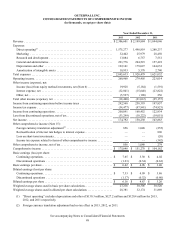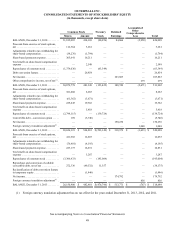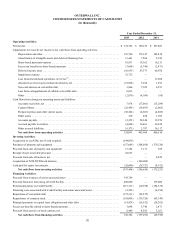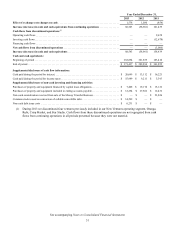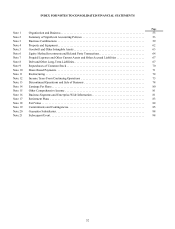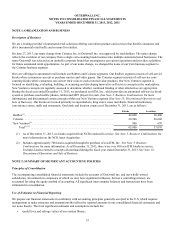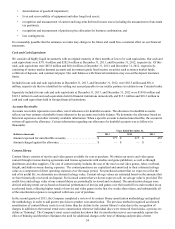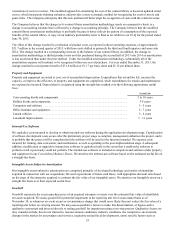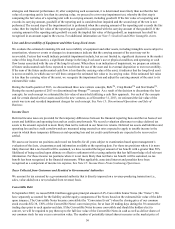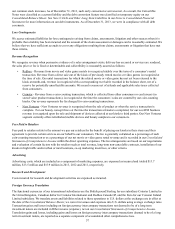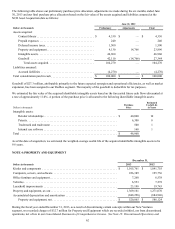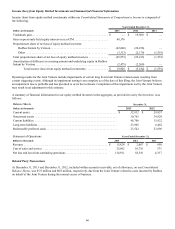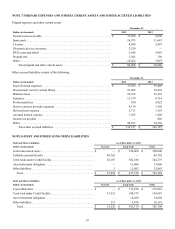Redbox 2013 Annual Report Download - page 67
Download and view the complete annual report
Please find page 67 of the 2013 Redbox annual report below. You can navigate through the pages in the report by either clicking on the pages listed below, or by using the keyword search tool below to find specific information within the annual report.58
Share-Based Payments
We measure and recognize expense for all share-based payment awards granted, including employee stock options and
restricted stock awards, based on the estimated fair value of the award on the grant date. We utilize the Black-Scholes-Merton
(“BSM”) valuation model for valuing our stock option awards and the determination of the expenses.
The use of the BSM valuation model to estimate the fair value of stock option awards requires us to make judgments on
assumptions regarding the risk-free interest rate, expected dividend yield, expected term and expected volatility over the
expected term of the award. The assumptions used in calculating the fair value of share-based payment awards represent
management’s best estimates at the time they are made, but these estimates involve inherent uncertainties and the determination
of expense could be materially different in the future.
We amortize share-based payment expense on a straight-line basis over the vesting period of the individual award with
estimated forfeitures considered. Vesting periods are generally four years. Shares to be issued upon the exercise of stock
options will come from newly issued shares. The expense related to restricted stock granted to movie studios as part of license
agreements is adjusted based on the number of unvested shares and market price of our common stock each reporting period.
Share-based payment expense is only recognized on awards that ultimately vest. Therefore, we have reduced the share-based
payment expense to be recognized over the vesting period for anticipated future forfeitures. Forfeiture estimates are based on
historical forfeiture patterns. We review and assess our forfeiture estimates quarterly and update them if necessary. Any changes
to accumulated share-based payment expense are recognized in the period of change. If actual forfeitures differ significantly
from our estimates, our results of operations could be materially impacted. For additional information see Note 10: Share-
Based Payments.
Fair Value of Financial Instruments
The carrying amounts for cash equivalents approximate fair value, which is the amount for which the instrument could be
exchanged in a current transaction between willing parties. Our available-for-sale securities are marked to fair value on a
quarterly basis. The fair value of our revolving line of credit approximates its carrying amount. For additional information see
Note 18: Fair Value.
Accounting Pronouncements Adopted During the Current Year
In July 2012, the FASB issued ASU No. 2012-2, “Intangibles – Goodwill and Other (Topic 350): Testing Indefinite-Lived
Intangible Assets for Impairment” ("ASU 2012-2"). ASU 2012-2 allows an entity to first assess qualitative factors to determine
whether it is necessary to perform the quantitative impairment test for indefinite-lived intangible assets. An organization that
elects to perform a qualitative assessment no longer is required to perform the quantitative impairment test for an indefinite-
lived intangible asset if it is not more likely than not that the asset is impaired. ASU 2012-2, which applies to all public, private,
and not-for-profit organizations, is effective for annual and interim impairment tests performed for fiscal years beginning after
September 15, 2012. Our adoption of ASU 2012-2 in the first quarter of 2013 did not have a material impact on our financial
position, results of operations or cash flows.
On February 5, 2013, the FASB issued ASU No. 2013-2, “Reporting of Amounts Reclassified Out of Accumulated Other
Comprehensive Income” ("ASU 2013-2"). ASU 2013-2 was issued to address concerns raised in the initial issuance of ASU
No. 2011-5, “Presentation of Comprehensive Income”, for which the Board deferred the effective date of certain provisions
relating to the presentation of reclassification adjustments in the income statement. With the issuance of ASU 2013-2 entities
are now required to disclose:
• For items reclassified out of accumulated other comprehensive income and into net income in their entirety, the effect
of the reclassification on each affected net income line item; and
• For AOCI reclassification items that are not reclassified in their entirety into net income, a cross reference to other
required disclosures under generally accepted accounting standards in the United States ("US GAAP").
This information may be provided either in the notes or parenthetically on the face of the statement that reports net income as
long as all the information is disclosed in a single location. However, an entity is prohibited from providing this information
parenthetically on the face of the statement that reports net income if it has items that are not reclassified in their entirety into
net income. For public entities, ASU 2013-2 is effective for annual reporting periods beginning after December 15, 2012 and
interim periods within those years. Our adoption of ASU 2013-2 in the first quarter of 2013 did not have a material impact on
our financial position, results of operations or cash flows.


